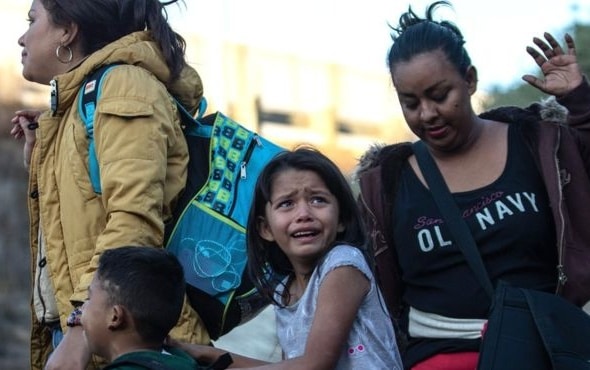Migrants at the US-Mexico border (Getty)
Pursuing his anti-immigrant campaign for the 2020 election, Donald Trump cuts aid to three Central American countries.
The State Department said Saturday that it is “ending…foreign assistance programs for the Northern Triangle” of El Salvador, Guatemala, and Honduras. The step halts almost $500 million in 2018 funds and millions more from the previous fiscal year.
The aid program, expanded during the Obama Administration, sought to deal with violence, lack of jobs, and poverty — the root causes of the migration that Trump says he want to halt.
Some Trump Administration officials argued that the program had not achieved enough and had considered alternatives. However, staff were surprised by the timing of Trump’s cutoff, a day after Homeland Security Secretary Kirstjen Nielsen signed a “historic” memorandum of cooperation on border security in Central America.
A former US official said there was “chaos” in the State Department and US Embassies as officials evaluated whether they should cancel existing contracts or simply not renew them.
Trump and his close advisors are convinced that their aggressive anti-immigration rhetoric and policies are a vote-winner for re-election in 2020. They have pursued The Wall with Mexico, shutting down the Federal Government for 35 days early this year and declaring a “national emergency” for construction of the 30-foot-high barrier. They have pursued a “zero tolerance” policy, trying to prevent asylum applications and separating children from parents.
Trump has repeatedly lied about an “invasion” of the US by migrants and drugs. In fact, migration across the Mexican border has decreased for more than 40 years although — fed by families fleeing conditions in Central America — there has been a recent increase, with more than 76,000 taken into custody in February.
On Friday, Trump started a new wave in the campaign. He declared in a series of tweets that he would close the border, snapping that “Mexico has for many years made a fortune off of the US”, and repeated the threat yesterday:
Mexico must use its very strong immigration laws to stop the many thousands of people trying to get into the USA. Our detention areas are maxed out & we will take no more illegals. Next step is to close the Border! This will also help us with stopping the Drug flow from Mexico!
— Donald J. Trump (@realDonaldTrump) March 30, 2019
Trump told reporters on Friday night, during a trip to Florida:
I’ve ended payments to Guatemala, to Honduras and El Salvador. No more money is going there anymore.
We were giving them $500 million. We were paying them tremendous amounts of money, and we’re not paying them anymore because they haven’t done a thing for us.
Aid groups explained that Trump’s action is likely to lead to an increase in migration by ending programs helping residents remain22 in Central America. Ken Baker, chief executive of Glasswing International, which runs education, health and entrepreneurship programs in El Salvador, said:
Ironically, our goals of having people stay and thrive in El Salvador are very similar to the current administration’s. Through our programs, we’ve been able to provide opportunities and the belief that they [would-be migrants] can thrive here.
The key is to get to them before [they leave]. When you’re talking about the problem at the border in the U.S., it’s already too late.”
Raúl López, El Salvador’s Vice Minister of Justice, said Friday that the flow of migrants from his country is slowing:
We see that as proof that our investment — and the investment of the international community — in social issues is working. US assistance has had a positive impact in reducing migration from El Salvador, but we need more help to continue this fight.
Mothers and Children “In Cages”
After decades of decline, migration into the US has surged as families try to make their claims before the onset of summer heat and before the Trump Administration closes off all possibilities.
The main border processing center in El Paso, Texas has been up to 400% of capacity, and other border stations are overcrowded. Kevin McAleenan, the commissioner of Customs and Border Protection, said last week that facilities are at “breaking point”.
In McAllen, Texas, the Border Patrol’s processing center has held 2,200 migrants, exceeding the facility’s limit of 1,500.
“Were the conditions horrible? Beauty is in the eye of the beholder, I guess,” Senator Jon Tester said after visiting the center last week. “I don’t think they were horrible, but by the same token it was gut-wrenching to see mothers and children sitting there in cages.”
Wayne Cornelius, a migration scholar at the University of California San Diego, explained: “The current surge was totally predictable and the Trump administration chose not to prepare for it. Instead it launched a raft of harsh deterrence measures that were totally ineffective.”
Analysts said that, as the Administration focused on “zero tolerance” to discourage migrants, it did not plan humane border reception facilities and measures to diminish violence and poverty in Central America.
Homeland Security Secretary Kirstjen Nielsen said on Friday that the agency is setting up a “crisis-response effort”: “The system is in free-fall. DHS is doing everything possible to respond to a growing humanitarian catastrophe while also securing our borders, but we have reached peak capacity and are now forced to pull from other missions to respond to the emergency.”

